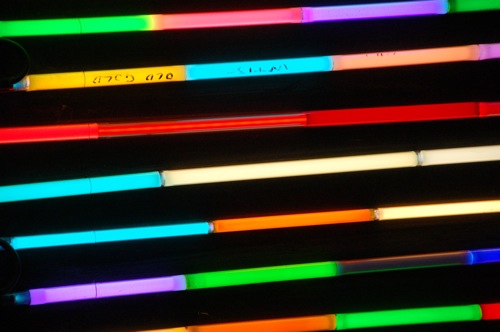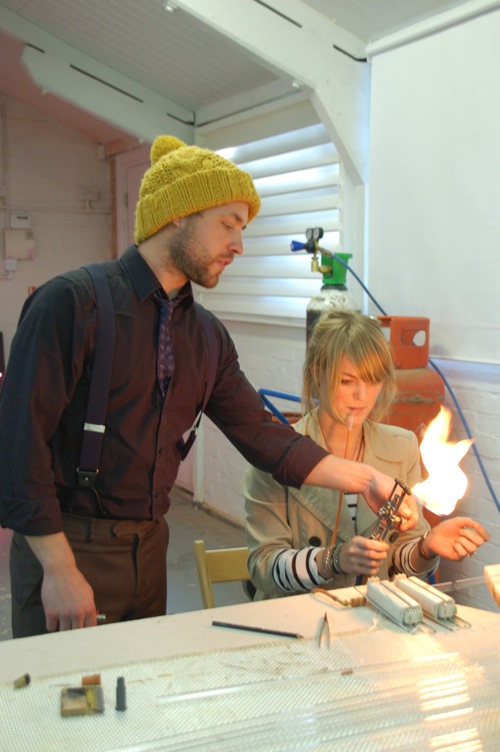 Sophie Haydock gives us a step by step guide to working with neon, at Europe’s only non-commercial neon craft space in Wakefield.
Sophie Haydock gives us a step by step guide to working with neon, at Europe’s only non-commercial neon craft space in Wakefield.
The bright-light world of neon is rather seductive. It may be carelessly associated with seedy backstreets and the red-light district, but who, in all honesty, doesn’t dream of seeing their name blazed in hot neon lettering?
In Yorkshire we are lucky enough to have access to one of the only places this side of the Pacific where that modest dream can become a reality.
Neon Workshops in Wakefield is the only non-commercial space in Europe that offers practical sessions in the craft of neon: how to design it, sculpt the glass tubes and fill them with gas. The one-day and one-week courses suit anyone with an interest in seeing their designs take neon form: artists, students, glass blowers – and even those with no previous technical ability (like me).
The artist who founded the Neon Workshops, Richard Wheater, runs them alongside a talented team, including Julia Bickerstaff, who is certainly an expert in her craft. Part of the workshop’s aim is to “challenge common expectations” of this luminous, unruly material.
Richard ultimately hopes that neon can shed its undeserved reputation. “People still think of garish pink, flashing signs and the red light district, but neon can actually be incredibly beautiful,” he says.
I took part in a one-day workshop (10am-5pm), and had the chance to turn my own design into a distinctive neon sculpture.
Step one Overview
The day starts with an introduction to neon: the history of the material, its significance to our culture, and a mention of the artists who are challenging the material to make stunning artwork, including the American Bruce Nauman.
Richard explains how the skill has disappeared from mainstream use in the UK in recent decades, but says that neon as a material should be celebrated because its light is different. “Other light can’t match it for depth,” he says.
We also discover that the word “neon” is misleading: it technically only refers to one shade – a reddish-orange, and not all colours. Although still referred to as neon, it’s by mixing other elements, including mercury (to make blue), carbon dioxide (for white) and helium (for gold). The availability of coloured glass tubes also helps achieve a full and diverse range of colours.
Step two How it’s done
In a tricky manoeuvre, Julia shows us how to bend the glass tubing by heating it under a gas flame. She simultaneously blows air into the tube to prevent it from collapsing in on itself. She effortlessly shapes the tube into a letter R to show us how to create both straight and curved lines.
 Step three Neon gas
Step three Neon gas
Now it gets technical. When the tube is sculpted, Richard processes it using an electron bombarder, which involves heating the glass with high voltage current until a ‘burning paper’ temperature is achieved. All this is conducted whilst the tube is under vacuum. Helium is used to clean the tube, again, in-conjunction with heat generated from a bombardment of high voltage electricity. Once certain the glass inside is clean, argon or neon gas is added and the tube is sealed off. With an argon-filled tube, you have to add a tiny amount of mercury, argon requires the vapour of the mercury in order to glow bright.
This part of the process has its risks; the glass tubing can crack because of the electricity punching a hole through the glass in order to find the quickest route from one electrode to the other. The glass section then has to go back to the workbench and be fixed. Mica is used as an insulator between tight bends of tubing to prevent this from happening.
Step four Our turn
We then get the chance to experiment (and make a few mistakes) with sample bits of glass. It’s trickier than it looks: handling the glass tubing, the hot flame and trying to keep the glass stable with a steady supply of air.
Step five Sketching
After lunch, we sketch out our designs, which are limited to 1m of glass tubing. I designed a bird to be made in white, which Julia helps me sketch out, with consideration of where the turns in the neon will need to be made.
Step six Making
Luckily, Julia is on hand to whip our designs into shape for us, without doing any damage to herself or her surroundings. She makes it look easy. “Working with neon is an unusual combination of art and science,” she says. “The glass often feels like it has a life of its own. It’s very difficult to control. But I like working with difficult materials – it makes life interesting.”
Step seven Viola!
The glass bird goes through the same process as the letter R, on the machine controlled by Richard. It is filled with a drop of mercury, the necessary gas is added and it is sealed off to produce a finished product.When it is first turned on, it glows a dull purplish white for around half an hour, but soon stabilises to a bright neon white.
Richard Wheater and the artist Victoria Lucas currently have an exhibition of large-scale neon lyrics, entitled 12 Months of Neon Love, visible on the roof above the Neon Workshops studio in Wakefield. The project was launched on February 14 this year and will last until February 2012. Each month, a new neon lyric will be decided on and crafted, all of which will be linked by containing the word ‘love’.
From February 14 to March 14, you could see the first in the series, a lyric from Elvis’s I’m All Shook Up, emblazoned in red neon – “I’m in Love / I’m All Shook Up / Uh Huh Huh”. Ths was followed by a Beautiful South lyric: “… Don’t do all the / talking Let love / speak up itself”. The current neon sign, on display now, is the Nirvana lyric ‘…Can you feel my love buzz…?’ The next sign in the series will be appearing soon.
I only read this because I followed a link from my Linkedin feed. I thought it said ‘Neon spacecraft’, not ‘Neon craftspace’ I’m glad I did though. Very interesting tech stuff and exciting to know anybody can do this.
Really interesting article, the workshops sound great!